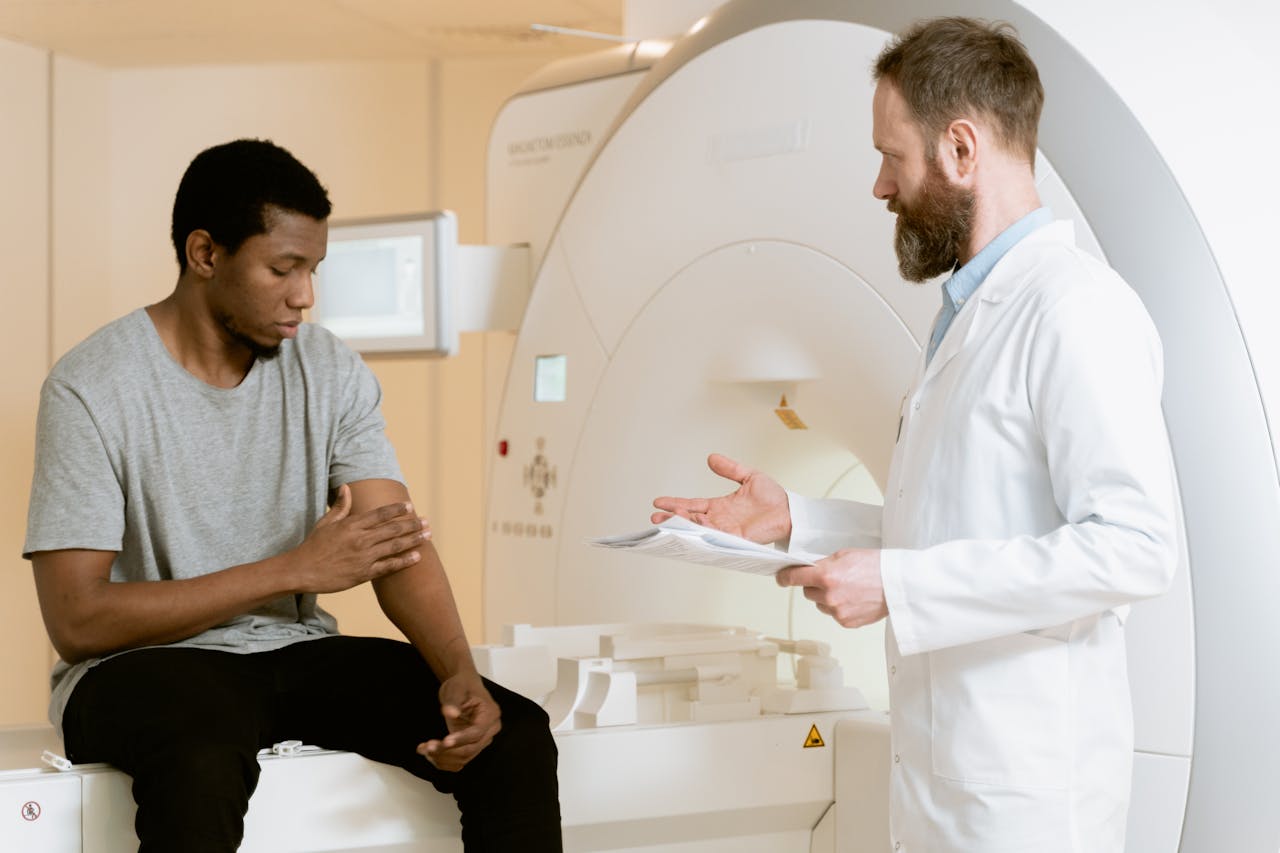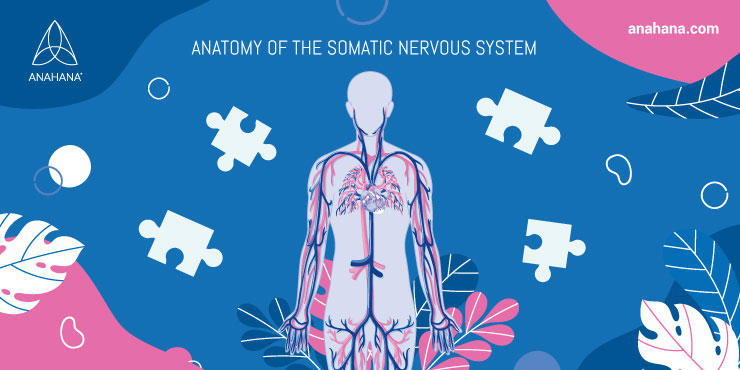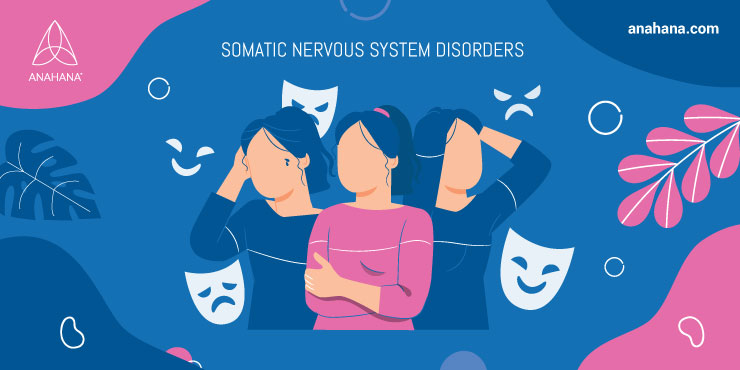
Table of Contents
The somatic nervous system (SNS) is the peripheral nervous system division responsible for all voluntary movement of the body. The somatic nervous system consists of relatively large sensory and motor nerves which conduct impulses rapidly, allowing us to respond quickly to stimuli in our environment.
Key Takeaways
- Definition: The somatic nervous system (SNS) is part of the peripheral nervous system, controlling voluntary movements and transmitting sensory information.
- Components: Includes sensory neurons, motor neurons, and the neuromuscular junction, facilitating communication between the brain and muscles.
- Functions: Responsible for voluntary muscle movements and reflex arcs, responding quickly to stimuli.
- Disorders: Can involve conditions like ALS, multiple sclerosis, and herniated disks, causing tremors and impaired motor function.
- Health: Maintaining a healthy diet and moderate exercise helps protect the SNS.
What is the somatic nervous system?
The somatic nervous system is under conscious control, meaning that we can choose to move our muscles or not. For example, when we decide to pick up a book, our brain sends signals down the motor neurons to our arm muscles, telling them to contract.
The somatic nervous system can also undergo unconscious activation. For example, when we trigger a reflex, use muscle memory, or automatically withdraw from a painful stimulus.
How does the SNS fit in with the rest of the nervous system?

The human nervous system splits into the central and peripheral nervous systems. The central nervous system (CNS) consists of the brain and spinal cord. The peripheral nervous system (PNS) consists of all the other nerves extending throughout the body.
Peripheral nerves connect the central nervous system with our organs, muscles, and glands. The PNS is divided into the somatic nervous and autonomic nervous systems.
The somatic nervous system (SNS) is the voluntary nervous system, meaning we can choose to activate it. Its primary responsibility is the conscious control of skeletal muscle movements. The SNS also deals with some involuntary movements, such as reflexes.
The autonomic nervous system (ANS) is responsible for the body’s involuntary functions, meaning it works automatically. It controls all the processes that keep us alive and functioning, such as heart rate, breathing, and digestion. The autonomic nervous system is further divided into the sympathetic (fight-or-flight) and parasympathetic (rest-and-digest) nervous systems.
The somatic and autonomic nervous systems often work together. For example, in bladder control: parasympathetic innervation allows urine to leave the bladder, but somatic (voluntary) muscle control is required to urinate.
Anatomy of the somatic nervous system

The somatic nervous system includes all nerves that innervate the skeletal muscles. These nerves originate in the spinal cord and brainstem and extend throughout the peripheral nervous system. Somatic nerves allow us to control our muscle movements voluntarily, but they can also be activated without a conscious decision (e.g., reflexes).
The somatic nervous system includes both sensory and motor neurons. Sensory neurons are afferent, meaning they send signals from the body to the brain. Efferent motor neurons do the opposite.
Somatic nerve fibers are insulated with relatively thick layers of myelin, so they conduct impulses rapidly. This allows us to respond quickly to stimuli in our environment.
Brain and spinal cord
The somatic nervous system is part of the peripheral nervous system, but the central nervous system is still crucial to its function. The brain interprets sensory input and signals motor responses to control the whole body. The motor cortex in the frontal lobe generates somatic motor impulses.
The spinal cord is a long column of nerves that travels down the back and transmits messages between the brain and other body parts. It is a crucial relay center for somatic motor neurons and the somatic reflex arc.
Some nerves involved in the somatic nervous system emerge directly from the brain and spinal cord. These are called cranial nerves and spinal nerves.
There are 12 pairs of cranial nerves, 10 of which originate in the brain stem. These nerves receive signals from sensory organs such as the eyes and nose. Cranial nerves also voluntarily control the muscles of the head.
There are 31 pairs of spinal nerves, which are associated with different regions of the spine. They carry somatosensory and voluntary motor signals between the periphery and the spinal cord.
Somatic sensory neurons
Sensory neurons in the somatic nervous system have endings in muscle, bone, and skin. They pick up somatic sensations, which are any sensations experienced by the body.
Somatic sensations can be either exteroceptive (outside the body) or proprioceptive (inside the body). Exteroceptive somatic sensations include touch, pain, temperature, and pressure.
Proprioceptive senses include joint position and muscle tension, and they help orient body positioning within the environment.
Somatic motor neurons
Motor neurons in the somatic nervous system innervate skeletal muscle. That is, all the muscles we can voluntarily control. There are two major types: upper motor neurons and lower motor neurons.
Upper motor neurons originate in the cerebral cortex of the brain. They synapse with lower motor neurons in the spinal cord, which go on to innervate the muscles.
Synapses are where nerves transmit chemical or electrical impulses to other nerves or the target tissue.
Upper motor neurons
The upper motor neurons are the nerve cells that carry signals from the brain to the spinal cord. They originate in the brain's primary motor cortex, located in the frontal lobe. The motor cortex generates the signals for voluntary motor control. Upper motor neurons follow two tracts: pyramidal and extrapyramidal.
Pyramidal Tract: Most upper motor neurons pass through the medullary pyramids in the brain stem, the region that connects the brain to the spinal cord.
These pyramidal tract fibers carry signals for all voluntary muscle movements, from broad to extremely precise.
Extrapyramidal Tract: These nerve fibers do not pass through the medullary pyramids as they go through the brain stem. Extrapyramidal tract fibers signal modifications to voluntary movements, such as speed and coordination.
They also transmit signals for involuntary motor control, such as posture, and actions that become involuntary over time, i.e., muscle memory.
Lower motor neurons
The lower motor neurons are the final link in the somatic nervous system. They originate in the spinal cord and innervate skeletal muscles throughout the body. When a lower motor neuron receives stimulation from an upper motor neuron, it causes the muscle to contract.
Lower motor neurons in the somatic nervous system consist of three types: alpha, beta, and gamma.
- Alpha Motor Neurons: These are the most abundant lower motor neurons in the somatic nervous system. Alpha motor neurons innervate the bulk of the muscle and drive contraction.
- Gamma Motor Neurons: Unlike alpha neurons, gamma neurons do not cause muscle contraction. Instead, they innervate the stretch-sensing fibers of the muscle and tell the alpha neurons to keep driving contraction.
- Beta Motor Neurons: Little known about the role of beta motor neurons. They innervate the same types of motor fibers as alpha and gamma motor neurons so that they may support the functions of the other two.
Lower motor neurons are also involved in the somatic reflex arc. Sensory nerves detect a particular stimulus and can synapse directly with lower motor neurons in the spinal cord to produce a specific muscle contraction. The reflex arc bypasses the brain, so these actions occur rapidly but involuntarily.
For example, tapping the patellar tendon below the knee causes the quadriceps to contract and extend the lower leg. The impulse from the sensory nerve can also travel through one or more interneurons to reach the motor nerve.
How does the SNS generate movement?

The human body contains three major muscle types: skeletal, cardiac, and smooth. Cardiac muscle makes up the heart, and smooth muscle occurs in internal systems such as the digestive tract. They are both controlled by the autonomic nervous system.
The somatic nervous system controls skeletal muscle, which typically comes to mind when we think of muscles. Examples of skeletal muscle include the biceps, triceps, and quadriceps.
When the lower motor neurons reach the muscle, they synapse with muscle fibers to form the neuromuscular junction. Muscle fibers are long, cylindrical cells that make up our muscles. Most muscle fibers are designed to generate an actual muscle contraction. Alpha motor neurons innervate them.
Muscle fibers that do not contract are called muscle spindles, and they detect the stretch of the muscle and are innervated by gamma motor neurons.
The steps of a muscle contraction from intention to action are:
- Somatosensory input tells the brain we should move (e.g., the hand is on a hot surface), or we simply decide to move (e.g., want to pick up a pencil).
- The primary motor cortex generates a motor signal.
- Upper motor neurons pick up the signal and carry it to the spinal cord.
- In the spinal cord, upper and lower motor neurons synapse.
- Lower motor neurons deliver the signal to muscle fibers via neuromuscular junctions.
- The signal triggers the contraction of muscle fibers and the muscle contracts.
- The muscle shortens and produces force to perform the intended action!
This rapid process repeatedly produces every little movement of our skeletal muscles.
Sensory input from the muscles and joints is sent back to the central nervous system, allowing us to monitor our movements and adjust them as needed. This feedback is called proprioception and is critical because it lets us know where our limbs are in space and how much force we exert.
Disorders of the somatic nervous system
 Damage to the somatic nervous system may occur anywhere between the motor cortex in the brain to the skeletal muscle itself. General terms for somatic nervous system disorders are motor neuron disease and peripheral neuropathy.
Damage to the somatic nervous system may occur anywhere between the motor cortex in the brain to the skeletal muscle itself. General terms for somatic nervous system disorders are motor neuron disease and peripheral neuropathy.
Symptoms often include tremors, muscle spasms, and impaired motor function. Some conditions are congenital, meaning a person is born with it, or they may develop throughout life.
Causes like injuries, viruses, and toxins may be genetic or external. The causes and risk factors are often unclear.
Examples of disorders involving the somatic nervous system include:
- Amyotrophic lateral sclerosis (ALS), also called Lou Gehrig’s disease
- Multiple sclerosis (MS)
- Poliomyelitis
- Herniated disk
- Radiculopathy (pinched nerve)
- Spinal cord trauma
Treatments for these conditions vary. Some may involve medications, and others may require surgery. Strategies to protect the overall health of the somatic nervous system include participating in moderate-intensity exercise regularly and consuming a diet low in fat and antioxidants.
Conclusion
The somatic nervous system is crucial for the control of all voluntary movement. Somatosensory nerves allow us to perceive information from the environment, such as pressure, temperature, and pain, as well as our body positioning.
Somatic motor nerves innervate the skeletal muscle of the body to produce motor responses accordingly.
Frequently asked questions
What are the responsibilities of the SNS?
The somatic nervous system provides conscious control of skeletal muscle movement. It is a division of the peripheral nervous system and includes sensory and motor neurons.
It is also involved in some unconscious motor functions (e.g., coordination of movements, working from muscle memory, reflexes).
What are examples of SNS functions?
There are many examples of the somatic nervous system in action. The somatic nervous system is responsible when you move your skeletal muscles. Examples include walking, running, lifting weights, and playing sports.
The somatic nervous system also controls the movements of your eyes and head, such as blinking and swallowing.
What are the main components of the SNS?
The main components of the SNS are the somatosensory neurons, motor cortex, upper and lower motor neurons, and neuromuscular junctions. Somatosensory neurons send information like pressure and touch to the brain.
The motor cortex generates a motor signal, which the upper motor neurons transmit to the spinal cord. Lower motor neurons carry the signal from the spinal cord to the muscle, transmitted through a neuromuscular junction.
How can I protect my SNS?
As we age, the somatic nervous system suffers some natural decline, leading to diminished sensory and motor control. This is often due to the deterioration of the neuromuscular junction (NMJ). Studies suggest that diet plays an influential role in NMJ health.
Experiments in mouse models found that avoiding high-fat diets and excess calorie intake can prevent NMJ deterioration and even reverse some types of damage.
Reactive oxygen species can also damage the NMJ. These free radicals are natural by-products of some bodily processes, including muscle contraction.
Our bodies usually produce antioxidants to counteract this, but increasing antioxidant intake can provide further NMJ protection. This may include vitamin D supplements, foods rich in vitamin E (e.g., spinach and tomatoes), and other antioxidant-rich foods (e.g., dark chocolate, blueberries, pecans, and kale).
Regular participation in moderate-intensity exercise can increase antioxidant production and prevent NMJ damage. Exhaustive exercise can cause excessive generation of reactive oxygen species and potentially overwhelm the body’s natural antioxidants.
Does the word “somatic” always refer to the SNS?
No, “somatic” actually means “related to the body.” The somatic nervous system has its name because its responsibilities include feeling and moving the body.
There can be some confusion because “somatic” is used in many terms outside the somatic nervous system.
For example:
- Somatic cells: Most cells that make up the body (skin, muscle, bone, nerves, etc.), as opposed to germ cells, which are reproductive cells (sperm, ova).
- Somatic syndrome disorder: A mental health condition in which a person shows specific physical symptoms, which may not always have an explained medical cause. While the physical symptoms may involve the SNS, this should not be confused with disorders of the SNS.
References
https://www.ncbi.nlm.nih.gov/books/NBK556027/
https://www.ncbi.nlm.nih.gov/books/NBK539845/
https://www.ncbi.nlm.nih.gov/books/NBK441977/
https://www.ncbi.nlm.nih.gov/books/NBK554616/
https://www.ncbi.nlm.nih.gov/books/NBK554542/
Disclaimer
The contents of this article are provided for informational purposes only and are not intended to substitute for professional medical advice, diagnosis, or treatment. It is always recommended to consult with a qualified healthcare provider before making any health-related changes or if you have any questions or concerns about your health. Anahana is not liable for any errors, omissions, or consequences that may occur from using the information provided.

By: Emma Lee
Emma is an editor for Anahana and a soon-to-be graduate of the Master of Science program at the University of Toronto. She graduated with a Bachelor’s in Neuroscience and Immunology at the University of Toronto and has extensive experience in research. She is passionate about learning the science behind health and wellness and hopes to contribute her knowledge to help people live healthier lives. Outside of Anahana, Emma enjoys exploring nature, playing with her dog, and doing arts and crafts.